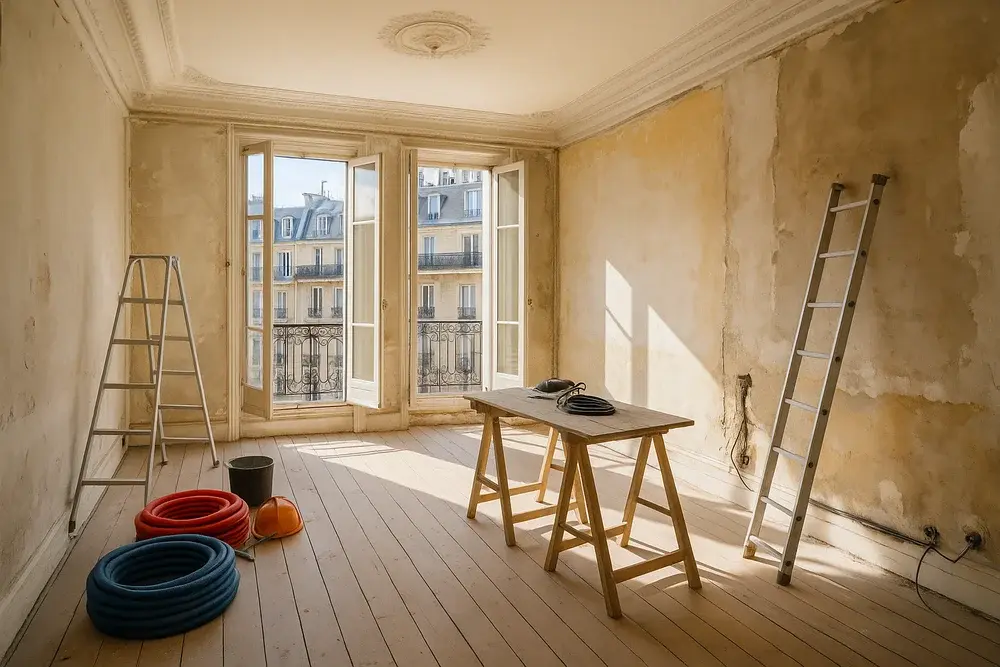Quartier Gambetta in Paris
Gambetta is a very pleasant district to live in, offering a perfect balance between tranquility and vitality. Many Parisians appreciate the calm and beauty of the Père Lachaise cemetery, the Gambetta district's generous choice of good restaurants and bars, and its cultural offerings. Place Gambetta is a great place to live. Property prices are reasonable compared with other Parisian neighborhoods.
.webp)
Quartier Gambetta Paris: origins and history
The Gambetta district is located to the east, in the 20th arrondissement of Paris. Its name comes from the Place Gambetta, the district's nerve center. Léon Gambetta was a famous and charismatic politician of the Third Republic. He was one of the fathers of the modern French Republic.
A neighborhood of working-class origins
Until the early 19th century, the area corresponding to today's Gambetta district was part of the independent communes of Charonne and Belleville. Parisians frequented these villages not only for their rural atmosphere, but also for their panoramic views over the city.
When Paris was enlarged under Napoleon III, the communes were annexed to form the 20th arrondissement.
Urbanization and modernization
The Gambetta district was transformed in the late 19th century, with the development of Place Gambetta as a central crossroads. The arrival of the metro and the first bus lines reinforced its role as a strategic crossroads linking the various sectors of eastern Paris.
Modernization intensified with the construction of Haussmann and Art Decobuildings to accommodate the growing population. Nevertheless, the district retains an architectural mix of luxury buildings and more modest dwellings.
A history of commitment
Historically, the Gambetta district has been associated with workers' movements and popular uprisings, notably during the Paris Commune of 1871, when Belleville and Ménilmontant were bastions of resistance. This militant heritage is still felt today in the identity of the neighborhood, which remains attached to a certain tradition of solidarity and cultural diversity.
Patrick offers you an overview of the Gambetta district in Paris
Architectural diversity in Paris's Gambetta district
The Gambetta district boasts a wide variety of building facade styles. They harmoniously coexist and respond to each other, testifying to the successive evolutions and influences that have left their mark on the district.
Haussmannian buildings are very much in evidence, with their ashlar facades, wrought-iron balconies and slate or zinc roofs. These buildings, most of which date from the late 19th century, symbolize the expansion and modernization of Paris under the Second Empire. Their high windows, elaborate cornices and decorative motifs are characteristic of the period. They are the most representative of Parisian urban décor.
Alongside these Belle Époque giants, more recent buildings illustrate the evolution of the urban landscape during the 20th century. Art Deco and Modernist buildings, with their cleaner lines and bolder shapes, add a touch of modernity. The Saint-Jean-Bosco church, for example, is a marvel of Art Deco, with its geometric lines and colorful mosaics.
Some remarkable buildings in the Gambetta district:
- A 1994 building by architect Michel Bourdeau at 132, rue des Pyrénées, featuring a variety of volumes;
- The ceramic facades of the Haies shower baths, a building dating from the 1920s;
- The multicolored frescoes at 13 rue du Retrait;
- If you're passing the post office at 250 rue des Pyrénées, take the time to stop and admire the frescoes by sculptor Zatkine (a great master of cubism), which you can see on the right as you enter the building;
- Finally, to rediscover the old-world charm of the Gambetta district, take a stroll through the narrow streets and secret passages, such as the Passage Perreur or the Passage Boudin. You'll discover cobbled lanes, secret courtyards and townhouses, often adorned with climbing vines or small gardens.
These quiet corners offer a striking contrast to the main boulevards, and are a reminder that Gambetta was once a working-class district, where artisans, workers and artists lived side by side.
{{cta-bordeaux-en}}
Quartier Gambetta: cultural life
Gambetta's identity is closely linked to the multitude of artistic expressions that take place here.
The Théâtre de la Colline, one of five national institutions dedicated to theater in Paris, is undoubtedly one of the district's cultural gems. Its bold programming, its commitment to supporting contemporary creation and its mission to be a place of encounter and debate make it much more than just a performance venue: it's a living space, where art is used to question society.
Just off Place Gambetta is La Bellevilloise, a former hotbed of working-class militancy, now a concert venue, theater, cabaret, restaurant and bar. A must for Parisian nightlife.
There are many independent bookshops in the Gambetta district, including Le Comptoir des Mots just off Place Gambetta.
Green spaces in the Gambetta district
In the midst of urban bustle, the Gambetta district is distinguished by its green oases, bubbles of tranquility that offer residents and visitors alike a breath of fresh air and a respite from the hustle and bustle of the city.
The Père-Lachaise cemetery is, without doubt, the neighborhood's most emblematic green space. Much more than just a cemetery, it's a historic park spanning 44 hectares. Its shady paths, dotted with ancient graves, century-old trees and majestic monuments, invite meditation and contemplation. Many people come here not only to pay homage to the many famous personalities buried here, but also to enjoy its serenity. In spring, you can admire the cherry blossoms.
Next to Père-Lachaise, the squares Samuel de Champlain and Square Édouard Vaillant offer another kind of verdant refuge. These small public gardens, with their children's play areas and manicured lawns, are ideal meeting places for local families. They are also places where residents can relax on a bench, read a book or simply observe life as it goes by.
Parc de Belleville, although located a little to the north of Gambetta, also deserves a mention. This terraced green space offers a breathtaking panoramic view of Paris. Its landscaped areas, such as the théâtre de verdure and playgrounds, make it popular with visitors of all ages. The shared gardens, managed by the residents themselves, are a testament to the neighborhood's dynamism and community spirit.
{{cta-vert-en}}
Local life and gastronomy in the Gambetta district
When you think of the Gambetta district, you can't ignore its vibrant local life, which is inextricably linked to its rich gastronomic scene. Indeed, this district, with its blend of Parisian traditions and cosmopolitan influences, is a veritable culinary crossroads.
The Belgrand market, near Place Gambetta, for example, is a meeting place for many locals who come here to pick up fresh, local and often organic produce. The stalls are bursting with color and scent, with a diversity of products that reflect the melting pot of the neighborhood's population: mature cheeses, artisanal charcuterie, seasonal fruits and vegetables, as well as exotic spices and specialties from around the world. The market is open on Wednesdays and Saturdays.
As for restaurants and cafés, the offer is abundant and of the highest quality. From traditional Parisian bistros with their large terraces, which make Parisians happy in summer, to world cuisine and gourmet restaurants.
Here are a few of our favorites:
- Galerna, a tapas restaurant at 7, rue du Cher ;
- Le Dancing Goat, a not-to-be-missed Parisian coffee shop at 177, avenue Gambetta ;
- Peppe Pizzeria, voted best pizza in Europe in 2021 and 2022, at 2, place Saint-Blaise.
For retail outlets, our favorites:
- Pilo's: a coffee shop, Argentinian tea room and pastries to die for. At the Père Lachaise entrance (Gambetta side). 1, av. du Père Lachaise ;
- La Gambette à Pain: competitive bakery. 86, av Gambetta ;
- Fromagerie Ancelot: small store for big cheeses. 119, av. Gambetta.
Numerous delicatessens and specialty stores enrich the gastronomic offering. From artisan chocolatiers and wine cellars to tea boutiques, these are places to shop and share.
Property market prices in Gambetta
The average price of apartments in Gambetta is around €9,000/m2. Beautiful apartments start at €10,500/m2. For houses, prices can sometimes rise to €14-15,000/m2 for exceptional homes.
Conclusion: Gambetta's lively village atmosphere
The Gambetta district embodies a rare balance between authentic neighborhood life and booming creative energy. With its lively streets, convivial terraces and cultural spaces, it attracts both young professionals in search of dynamism and families in search of urban gentility. This subtle blend of conviviality and modernity makes it one of the neighborhoods where people settle as much for its trendy addresses as for its unspoiled Parisian village atmosphere.




